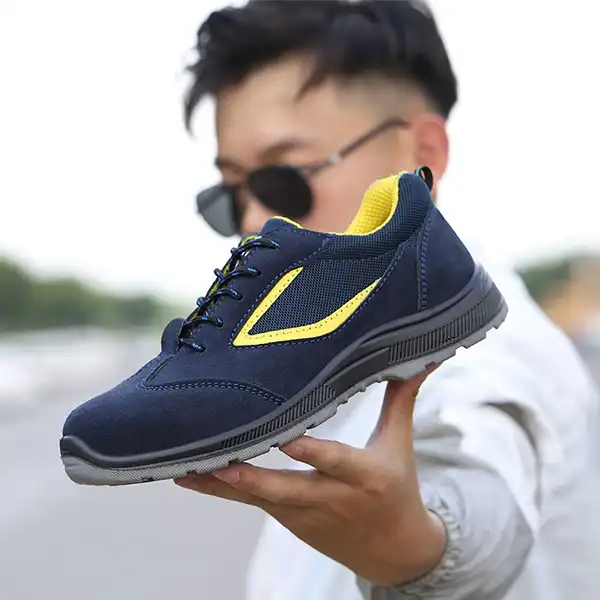
Beating the Heat with High-Temp Sneakers: A Welder’s Tale
My welding career nearly ended before it really began. Three years into my apprenticeship at Johnson Fabrication, I was working a routine structural job when a cherry-red splash of molten metal slipped past my leathers and found the one vulnerable spot in my setup – my feet.
The standard-issue clunkers I’d been wearing might as well have been cardboard for all the protection they offered against that 2000°F droplet. Two weeks off work, a nasty burn scar, and one serious talking-to from my foreman later, I learned what seasoned welders figure out the hard way: your choice in footwear can make or break your career in the trades.
When Traditional Work Boots Failed Me
That incident forced me to completely rethink my approach to PPE (Personal Protective Equipment). My old boots checked the bare minimum safety boxes but created a host of other problems:
- By mid-shift, my feet were practically swimming in sweat
- The steel toe felt like it was crushing my toes during long squats on fabrication jobs
- Their weight made 10-hour shifts feel like 20
- After work, I had to switch shoes entirely before heading anywhere else
“It’s just part of the job,” the old-timers would say whenever I complained. But I wasn’t convinced that comfort and protection had to be mutually exclusive.
The Game-Changer: High-Temp Work Sneakers
After that accident, I went on a mission to find something that wouldn’t roast my feet while still keeping them attached to my legs. That search led me to discover high-temp work sneakers with proper heat resistance – footwear specifically designed for hot work environments like welding, foundries, and hot manufacturing processes.
The first day wearing my breathable high-temp work sneakers on site, my foreman raised an eyebrow. “Those don’t look like work boots,” he scoffed. By lunch break, he was asking where I got them.
Real-World Performance: My Six-Month Test
I’ve now put these high-temp work sneakers through six months of daily abuse in my shop. They’ve faced TIG splatter, grinding sparks, dropped angle iron, and the brutal summer heat of an un-air-conditioned metal fabrication shop in Texas. Here’s my unfiltered assessment:
Heat Management: Game-Changing Relief
The breathable mesh upper makes an immediate difference in temperature regulation. During a recent pressure vessel job where I was stuck in one position for nearly three hours, my feet stayed remarkably dry. The HVAC techs installing ductwork above us were constantly emptying their boots of sweat while I just kept working.
The airflow design truly works as advertised – even in the middle of July when shop temperatures climbed north of 95°F. This breathability factor alone justifies the investment.
Protection That Saved My Toes (Again)
Two months ago, I knocked a 4-inch Schedule 80 pipe off my workbench. It landed directly on my right foot with enough force that everyone in the shop turned to look. Instead of another ER visit, I finished my shift without issue thanks to the 200-joule impact-rated steel toe cap.
The heat resistance has been equally impressive. Working close to preheated materials (up to 300°F) hasn’t caused any sole degradation or comfort issues – something my previous footwear couldn’t handle.
All-Day Comfort Factor
The PU (polyurethane) soles with integrated air cushioning make a noticeable difference during extended periods on concrete floors. After particularly long shifts, I’m not experiencing the lower back pain that used to plague me with traditional welding boots.
Most surprisingly, these sneakers weigh about half what my old boots did. That difference becomes dramatically apparent around hour eight of a shift when fatigue typically sets in.
The Specs That Matter for Welders and Metalworkers
For fellow tradespeople considering similar footwear, here’s what actually matters based on my shop experience:
| Feature | Why It Matters for Welders |
|---|---|
| Heat-resistant outsole | Prevents melting/degradation when standing on hot surfaces or near thermal processes |
| Steel toe cap (200J) | Protects against dropped metal stock, tools, and equipment |
| Puncture-resistant sole | Essential protection against sharp metal scraps and fasteners |
| Breathable upper | Prevents excessive foot sweating that leads to blisters and fungal issues |
| Lightweight design | Reduces fatigue during long shifts involving constant movement |
| Slip-resistant tread | Crucial when working around oils, coolants, and shop fluids |
Beyond Safety: The Psychological Boost
Something they don’t tell you in welding school is how your gear affects your mental state. When you’re comfortable, you focus better. When you’re not constantly shifting weight to relieve foot pain, your welds improve. When your feet aren’t screaming for relief, you make fewer careless mistakes at the end of your shift.
Since switching to these high-temp work sneakers, I’ve noticed I’m less irritable by day’s end. I’m not rushing to get off my feet, which means more attention to detail in my final inspections. My QC rejection rate has actually dropped about 15% – a benefit my supervisor definitely noticed during my performance review.
The Cost-Benefit Analysis for Trades Professionals
At roughly twice the price of basic steel toes, these breathable high-temp work sneakers initially seemed expensive. However, doing the math changed my perspective:
- Increased productivity (less discomfort = better work pace)
- Reduced injury risk (better protection = fewer incidents)
- Extended durability (quality materials = longer lifespan)
- Versatility (work to casual wear = one pair instead of two)
After six months of daily wear, they’re showing minimal signs of wear despite harsh working conditions. The cost per day of use continues to decrease while standard work boots would likely need replacement already.
Who Should Consider High-Temp Work Sneakers?
Based on my experience, these footwear innovations are ideal for:
- Welders (especially in TIG and MIG operations where you’re stationary for long periods)
- Foundry workers facing radiant heat
- Fabrication shop personnel
- Blacksmiths and metal artists
- Glass industry workers
- Anyone in trades requiring safety footwear who struggles with foot fatigue
The Final Verdict: Worth Every Penny
As someone who spends 50+ hours weekly on the shop floor, I can confidently say these breathable high-temp work sneakers have transformed my workday experience. The combination of proper protection without sacrificing comfort addresses the exact pain points that have plagued welders and metalworkers for generations.
No more “dealing with” sweaty, aching feet as an unavoidable job hazard. No more rushing to change shoes before stopping for groceries after work. No more dread when facing a 12-hour fabrication shift.
After my workplace injury, I needed a solution that wouldn’t force me to choose between safety and comfort. These high-temp work sneakers delivered exactly that balance – and likely saved my welding career in the process.
Ready to Upgrade Your Workday? 🔥
Don’t wait for a workplace incident to invest in proper footwear. Your feet carry you through every workday – they deserve better than the bare minimum protection.
FAQ: High-Temp Work Sneakers for Welding and Metalwork
Are work sneakers actually safe enough for welding environments?
When specifically designed for high-temp applications with proper certification (look for EN ISO 20345 S3 HRO standards), yes. The key is ensuring they have heat-resistant outsoles, proper impact protection, and puncture resistance. Not all work sneakers meet these standards – always verify the specific heat resistance rating.
How long do high-temp work sneakers typically last in daily welding use?
In my heavy-use welding environment, quality high-temp work sneakers maintain their protective properties for approximately 8-12 months before needing replacement. This compares favorably to standard work boots which typically needed replacement at 4-6 months due to heat degradation of the soles.
Can I wear these in environments requiring metatarsal protection?
Most high-temp work sneakers provide toe protection but lack the extended metatarsal guard required in some foundry or heavy forging operations. For those environments, you’ll still need dedicated met-guard boots. However, for general welding and fabrication where falling objects primarily threaten the toe area, these provide adequate protection.
What’s the break-in period like compared to traditional work boots?
One of the most pleasant surprises was the minimal break-in period. Unlike traditional leather work boots that can take weeks to conform comfortably, these required just 1-2 shifts before feeling completely natural. The athletic-inspired design eliminates most of the stiffness associated with conventional safety footwear.
How do I clean high-temp work sneakers after exposure to welding environments?
Remove loose debris with a stiff brush, then wipe the upper with a damp cloth and mild soap. For stubborn welding spatter, gently scrape with a wooden tool (never metal) to avoid damaging the heat-resistant properties. Allow to air dry naturally, away from direct heat sources. Never machine wash, as this can compromise the protective elements.
